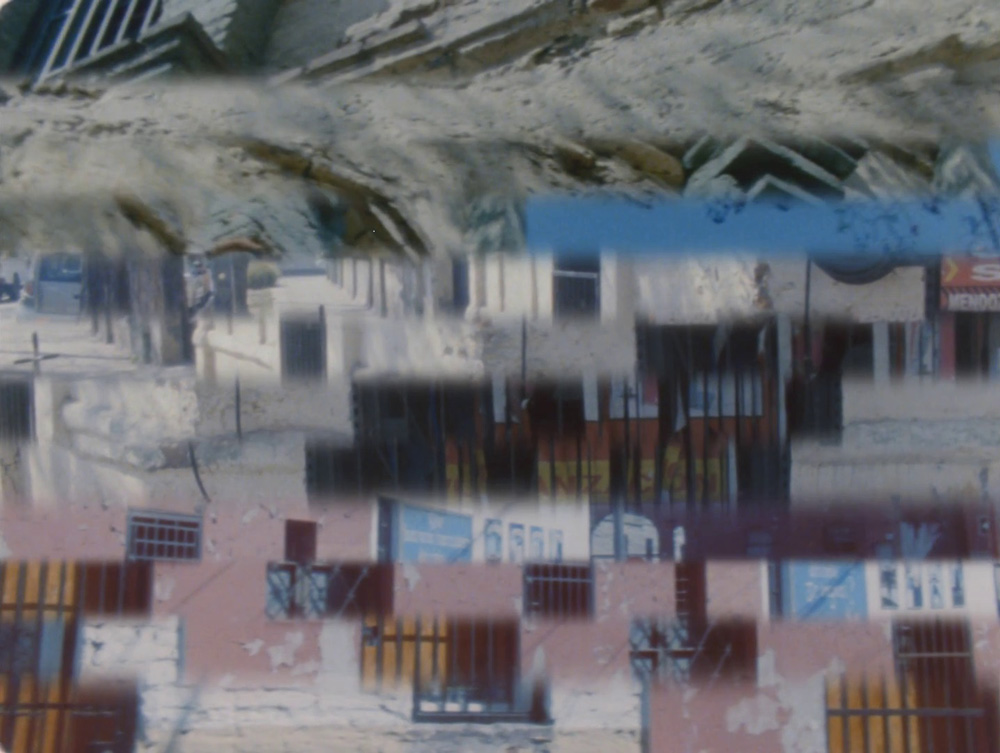Selection #9Terrestrial Mechanics
53 mins
Enclosed in the revolving mechanism of a Ferris wheel or on a train ride through the Canadian Shield, from shifting tectonic plates to melting alpine pixels, the look glides through planetary gears, clinging to moving panoramas traversed by landslides and avalanches. Landscape is exposed in its geological layers, laminated and dissected by analog and digital techniques, applying the pressure of time as a torque on the screen and turning it into a dizzying optical machine.
Terrestrial Mechanics
53 mins Enclosed in the revolving mechanism of a Ferris wheel or on a train ride through the Canadian Shield, from shifting tectonic plates to melting alpine pixels, the look glides through planetary gears, clinging to moving panoramas traversed by landslides and avalanches. Landscape is exposed in its geological layers, laminated and dissected by analog and digital techniques, applying the pressure of time as a torque on the screen and turning it into a dizzying optical machine.
Sun 25 Oct
20:00 - 21:00 / ACUD KINOTomonari Nishikawa
Amusement Ride
2019, Japan, 16mm, col, sound, 6'

Shot with a telephoto lens from inside a cabin of Cosmo Clock 21, a Ferris wheel at an amusement park in Yokohama, Japan. The distorted image shows the structure of the Ferris wheel, focusing on the intermittent vertical movement, which resembles the movement of a film at the gate of a film projector or camera.
Richard Tuohy
Valpi
2019, Australia/Chile, 16mm, col, sound, 9'

A city of brick, tin and board. A city on the edge of a continent. A city grinding under the weight of tectonic pressures. Valparaiso.
Allan Brown
Ruins: Shield: Artifice
2020, Canada, 16mm, col, sound, 13'

The Canadian Shield seen through the window of a remote train journey in northern Quebec.
Robert Orlowski
Continuous Becoming
2019, USA, 16mm, col, sound, 9'

Utilizing the concept of space-time popularized by Einstein’s special relativity, Continuous Becoming attempts to translate 4 dimensional space through the 2 dimensional plane. The film revolves around the axis of a 360 degree camera rotation. With each rotation, partitions are gradually added dividing the frame, each of which are off-set by a frame ahead in time. The image, once fixed by a single locality and temporality, slowly becomes a malleable surface susceptible to the pressures of expanding space-time. Near the end of the film, the entire duration of the pan is displayed on screen. But at this point, could the entirety of the film be shown at once? Space and time are no longer passive conduits of the image, but rather fissures in our understanding of cinematic geography.
Jacques Perconte
Avant l'effondrement du Mont Blanc
2020, France, HD, col, sound, 16'

Are we the very last to see the peaks of Mont Blanc? The heat of the summers and the mild winters have a lot to do with the rock falls, which have multiplied over the last twenty years or so. The mountains are collapsing. If this is a sign of climate change, it is also a sign of our attachment to the landscape, which we would like to be able to classify as a heritage site.The Mont Blanc massif is not ours, the mountain is a state, it is a moment, it wasn't there millions years ago, and it will change in any case. The problem here would be that of speed of change. Because the equilibrium of these peaks defying the void, the longevity of these glaciers is only our point of view. On the scale of the planet's motion, it's a vibration. Mountains are falling, and there's nothing we can do about it. And even if we have the means to rise to their height to admire them, to surpass those inaccessible peaks where many explorers lost their lives trying to gain the privilege of overcoming them, the mountains will continue to fall as they continue to rise. If Mont Blanc falls, it also rises.
SCHEDULE 2020
Thu 22
19:00 / ACUD KUNSTHAUS Festival Opening
20:30 / ACUD STUDIO
Selection #1
What Can A Body Do?
21:30 / ACUD STUDIO
Selection #2
Coming Of Ages
19:30 - 21:00 / ACUD GALLERY
Occulto presents
Glaring Sounds
Marta De Pascalis & Filippo Vogliazzo
Installation
Fri 23
17:00 / ACUD STUDIO
Selection #3
Detritus
18:30 / ACUD STUDIO
Selection #4
A Home Is A Hallway
20:00 / ACUD KINO
Special Programme
Focus
Paolo Gioli,
Claudine Eizykman
Analog Screening
19:30 - 21:00 / ACUD GALLERY
Occulto presents
Glaring Sounds
Marta De Pascalis & Filippo Vogliazzo
Installation
Sat 24
17:00 / ACUD STUDIO
Selection #5
Memory Palace
18:30 / ACUD STUDIO
Selection #6
Hidden Voices
20:00 / ACUD KINO
Special Programme
Focus
Paolo Gioli,
Claudine Eizykman
Analog Screening
19:30 - 21:00 / ACUD GALLERY
Occulto presents
Glaring Sounds
Marta De Pascalis & Filippo Vogliazzo
Installation
Sun 25
16:30 / ACUD STUDIO
Selection #7 The Places We Go,
The Ways That We Fall Apart
18:00 / ACUD STUDIO
Selection #8
The World Of Breathing
20:00 / ACUD KINO
Selection #9
Terrestrial Mechanics
21:30 / ACUD KINO
Selection #10
Visible Limits
19:30 - 21:00 / ACUD GALLERY
Occulto presents
Glaring Sounds
Marta De Pascalis & Filippo Vogliazzo
Installation